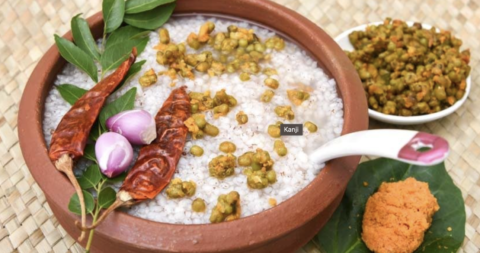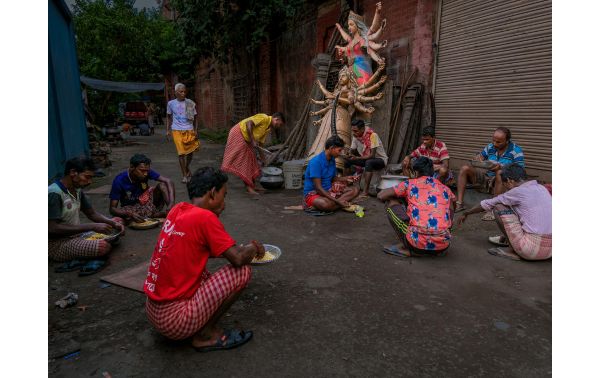Rooted in the economics of survival, Dalit cuisine thrives on making the most of meagre resources. Pork and beef, scorned by the upper castes, find a revered place on Dalit plates, not out of choice, but as a defiant assertion of culinary autonomy.
In the words of Deepa Balkisan Tak, Dalit cuisine isn’t about choice but about the lack thereof. It’s about reclaiming agency in a society that seeks to strip it away.
Rakti
Dalit kitchens placed amidst the backdrop of social hierarchy and economic constraints, a simple yet profound dish emerges: Rakti, coagulated blood, cherished not just for its taste but specially for its deep-rooted significance in Dalit cuisine.
Prepared with resourcefulness and ingenuity, Rakti embodies the essence of survival cooking. In a modest pan, oil sizzles as onions, if available, dance in the heat. Then, the main ingredient, blood, is poured in—a precious commodity, transformed into a delicacy through skilful hands and simple seasonings of chili powder and salt. For Dalit communities, Rakti isn’t just a meal; it’s a symbol of resilience against oppression. In a society where food hierarchy dictates social standing, where dietary choices are shackled by caste norms, Rakti stands defiantly as a reminder of autonomy and self-sufficiency. As Dr. B.R. Ambedkar rightfully stated, the caste system segregates individuals into distinct identities based on their dietary practices. Yet, within this rigid framework, Dalit cuisine emerges as a testament to ingenuity born of necessity.
Rakti, with its humble origins and profound symbolism, embodies the resilience and defiance of a community determined to carve out their own identity, one meal at a time.
Pazhankanji
“Pazhankanji,” affectionately known as “rice gruel” in Kerala, isn’t just sustenance; it’s a narrative deeply ingrained in the fabric of Kerala’s cultural identity—a tale of endurance, resistance, and adaptation against the backdrop of caste oppression.
Once a humble fare relegated to the fringes of society, pazhankanji sustained the lower castes and economically disadvantaged with its simple ingredients—leftover rice soaked overnight and served with scant accompaniments like salt or pickle. Yet, its significance transcended its modest origins, serving as a poignant symbol of solidarity amidst social inequities.
In the annals of Kerala’s history, pazhankanji stands as a testament to the resilience of those marginalized by caste-based discrimination. Its consumption was not merely about filling empty stomachs but also about asserting agency and reclaiming dignity in the face of systemic injustices.

However, as Kerala evolves, so too does the narrative surrounding pazhankanji. No longer confined to the margins of society, it has undergone a metamorphosis—a culinary revival, if you will. Recognized for its nutritional richness and health-promoting properties, pazhankanji has emerged as a revered superfood in contemporary Kerala.
This newfound acclaim represents more than just a culinary trend; it symbolizes a cultural renaissance—a rediscovery of traditional practices and a celebration of Kerala’s culinary heritage. In embracing pazhankanji as a superfood, Kerala embraces its past while looking toward a healthier, more inclusive future.
The story of pazhankanji mirrors Kerala’s journey—a journey marked by resilience, adaptation, and the relentless pursuit of social justice. From its humble beginnings as a symbol of oppression to its current status as a beacon of nutritional wisdom, pazhankanji’s evolution embodies the spirit of Kerala—a spirit that thrives on tradition, innovation, and the enduring quest for equality.
Red-Ant Chutney
In the heart of the forest, a cherished tradition thrives among the Adivasi communities of Odisha and Chhattisgarh. At its core lies a dish that’s as beloved as it is nourishing : red ant chutney or kai or chapda.
For generations, families have ventured into the woods, baskets in hand, on a quest for the tiny yet mighty red ants that call the undergrowth home. With laughter and shared stories, they carefully gather the insects, mindful of their potent sting but appreciative of their role in their culinary heritage.
Back at home, in kitchens filled with memories and the comforting scent of spices, the real magic unfolds. Over an open flame, the ants are roasted, their earthy aroma mingling with the fragrance of spices collected from the forest floor. With practiced hands and a touch of love, they’re transformed into a chutney that bursts with flavor—a true testament to the artistry of Adivasi cooking.

But red ant chutney is more than just a dish; it’s a connection to the land and its bounty, a reminder of the deep bond between people and nature. As families gather around the table to share a meal, they’re nourished not only by the food but also by the stories and traditions that have sustained their community for generations.
And beyond its culinary delights, red ant chutney holds another secret—it’s believed to possess medicinal properties, passed down through generations as ancient wisdom. With each spoonful, there’s a whisper of healing, a hint of nature’s magic that soothes both body and soul.
In every jar of red ant chutney, there’s a story—a story of resilience, tradition, and the enduring spirit of the Adivasi people. It’s a reminder that even in a fast-paced world, the old ways still hold power and that the land has much to teach us about sustenance, healing, and the beauty of living in harmony with nature.
By – Tusshar Yadav
